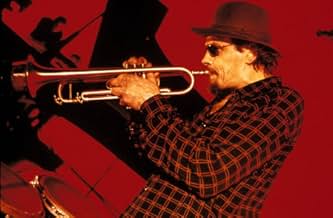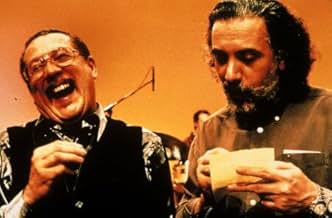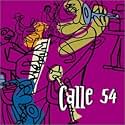Füge eine Handlung in deiner Sprache hinzuA film featuring performances of several stars of the Latin Jazz music scene.A film featuring performances of several stars of the Latin Jazz music scene.A film featuring performances of several stars of the Latin Jazz music scene.
- Auszeichnungen
- 4 Gewinne & 5 Nominierungen insgesamt
Maximilian Schweiger
- Baritone Saxophone
- (as Max Schweiger)
Papo Vázquez
- Trombone
- (as Papo Vasquez)
Empfohlene Bewertungen
If you are a music lover, any kind of music, this is a must see.
The introductions are brief and tasteful but the main strength of the film is that the performances are complete and very skillfully filmed, always in concordance with the rhythm and flow of each composition. Each performer gets to play in the same set in 54th street in Manhattan (hence the name) but with different colors reflecting the personality of the group or individual.
The common thread between all acts is that the music and performance is front and center, any context or description given are just a plus and the viewer is left alone to enjoy the virtuosos at work.
It's inevitable to pick favorites among all acts, for me Michel Camilo's dexterity, timing and taste are top.
The introductions are brief and tasteful but the main strength of the film is that the performances are complete and very skillfully filmed, always in concordance with the rhythm and flow of each composition. Each performer gets to play in the same set in 54th street in Manhattan (hence the name) but with different colors reflecting the personality of the group or individual.
The common thread between all acts is that the music and performance is front and center, any context or description given are just a plus and the viewer is left alone to enjoy the virtuosos at work.
It's inevitable to pick favorites among all acts, for me Michel Camilo's dexterity, timing and taste are top.
This is a fine collection of performances. I enjoyed Tito Puente's segment most--it's a nice farewell to a great musician. He evokes the men who preceded him, like Mario Bauza, Machito and Chano Pozo (whose conga playing on records with Dizzy Gillespie was a great joy of my teenage years). Bebo Valdes was also wonderful; alone, or in duets with his son Chucho or with Cachao. The only sour note was provided by the schlockmeister Gato Barbieri, purveying dull world music (does anybody remember the soundtrack album for Last Tango In Paris? that was great make-out music from Gato).
I liked this a lot more than Carlos Saura's banal flamenco and tango films, which were the last gasps of a dying filmmaker.
I liked this a lot more than Carlos Saura's banal flamenco and tango films, which were the last gasps of a dying filmmaker.
I can't understand why Miramax isn't promoting this movie to the hilt. It's a wonderful concert film posing as a documentary about the history of latin jazz in the US. The director Fernando Trueba has an obvious jones for latin jazz and has chosen to focus on some of the genre's most influential performers and founders, keeping the narrative to a minimum and letting the music speak for itself. And that's where the movie really shines: over and over each artist gives a wonderful performance with lighting and simple set design to make them look their best. The film will probably draw inevitable comparisons to "Buena Vista Social Club", another film presenting latin artists making history through their music. However BVSC focused as much on Ry Cooder's involvement and the musicians' lives in Cuba as the music played. Here Trueba keeps the education brief, and when the performers play, you know why latin jazz changed his life. A terrific date film for anyone who loves music and the chance to see such giants as Tito Puente, Gato Barbieri, Paquito D'Rivera and historic moments shared by Bebo Valdes and his son Chucho as well as his lifelong friend Cachao.
For the jazz lovers, this is a must. Fabulous musicians doing their thing. The highlight being Michel Camilo in a performance which caused our audience to erupt in appreciative applause. Oh to see him perform live!!! Worth watching the movie for that performance alone.
I have not enjoyed a music film so much since `West Side Story'. Basically my musical preferences reside in classical music, but not at the cost of excluding other kinds. Such that in my collection of records and CDs I have music from Tomás Luis de Victoria to Vangelis. And a little jazz: not much, it is true, but the likes of Miles Davis or Dizzy Gillespie did not pass through this world unnoticed. Whereas I can sit through an opera or even 100 minutes of `Le Grande Messe des Morts' by Hector Berlioz, I tend to take certain kinds of music such as jazz in smaller doses, so that I do not get tired of it. Paco de Lucía, Janis Joplin, Dave Brubeck, John McLaughlin's Friday Night in San Francisco
. Fine: but not more than about 30-40 minutes.
So I was a little worried about sitting through 100 minutes of `Calle 54'. On the one hand, I do not mind watching an opera, though preferably when listening to the great classics I am at home with my own equipment; but on the other, I love WATCHING jazz musicians! They seem to be having such a great time! You grunted along with Garner, thrilled at Armstrong when he got his trumpet going, and you felt the vibes the same as they did.
Fernando Trueba is a bit like me: you do not listen to music with your ears; you feel it with the whole of your body. At home I often get up and take a little stick and conduct the record I am listening to. Other people dance to music. I don't: I have to feel the music and make out I am directing the orchestra!
`Calle 54' is a pure joy from start to finish. It's a feast for the eyes and ears and all the adrenalin and corpuscles, which race around up and down finger-fired keyboards and sensual saxes, and throbbing with batteries and pulsing double-bases. And then there is the camera-work: six of them always on the move, closing in, panning out, every kind of imaginable angle, focussing on fingers caressing chords or dancing over sax and piano keys or following the sticks up and down the xylophone and then the miraculous task of editing all that, piecing all six together. Carmen Frías has done a wonderful job, indeed. And she declares she was not even a knowledgeable person in the world of jazz! Virtually all of it was from first takes; practically nothing was later `doctored': thus it all came out hot, just as it should be heard, not nicely rehearsed and then sewn together such that afterwards that would be what it would sound like rehearsed and sewn together.
This Latin version of Afro-American jazz is an impressive document; from Río and Cuba and Puerto Rico, from Cádiz and Sweden to New York, Fernando Trueba has pieced together this delicious, delightful `concert', a real treat, a once-and-forever: some of the musicians taking part, like Tito Puente, have since died. Am I glad Sr. Trueba got in there in time to bring us this invigorating gem!
So I was a little worried about sitting through 100 minutes of `Calle 54'. On the one hand, I do not mind watching an opera, though preferably when listening to the great classics I am at home with my own equipment; but on the other, I love WATCHING jazz musicians! They seem to be having such a great time! You grunted along with Garner, thrilled at Armstrong when he got his trumpet going, and you felt the vibes the same as they did.
Fernando Trueba is a bit like me: you do not listen to music with your ears; you feel it with the whole of your body. At home I often get up and take a little stick and conduct the record I am listening to. Other people dance to music. I don't: I have to feel the music and make out I am directing the orchestra!
`Calle 54' is a pure joy from start to finish. It's a feast for the eyes and ears and all the adrenalin and corpuscles, which race around up and down finger-fired keyboards and sensual saxes, and throbbing with batteries and pulsing double-bases. And then there is the camera-work: six of them always on the move, closing in, panning out, every kind of imaginable angle, focussing on fingers caressing chords or dancing over sax and piano keys or following the sticks up and down the xylophone and then the miraculous task of editing all that, piecing all six together. Carmen Frías has done a wonderful job, indeed. And she declares she was not even a knowledgeable person in the world of jazz! Virtually all of it was from first takes; practically nothing was later `doctored': thus it all came out hot, just as it should be heard, not nicely rehearsed and then sewn together such that afterwards that would be what it would sound like rehearsed and sewn together.
This Latin version of Afro-American jazz is an impressive document; from Río and Cuba and Puerto Rico, from Cádiz and Sweden to New York, Fernando Trueba has pieced together this delicious, delightful `concert', a real treat, a once-and-forever: some of the musicians taking part, like Tito Puente, have since died. Am I glad Sr. Trueba got in there in time to bring us this invigorating gem!
Wusstest du schon
- Crazy CreditsJerry González is shown in concert repeating the names of the featured performers of the film while the screen splits into multiple part with each featuring footage and the name of each performer as the names are called out. In addition there are smaller boxes with the other bandmembers and their names seen in this film.
- SoundtracksPanamericana
Performed by Paquito D'Rivera
Top-Auswahl
Melde dich zum Bewerten an und greife auf die Watchlist für personalisierte Empfehlungen zu.
Details
- Erscheinungsdatum
- Herkunftsländer
- Offizieller Standort
- Sprachen
- Auch bekannt als
- Калле 54
- Drehorte
- Produktionsfirmen
- Weitere beteiligte Unternehmen bei IMDbPro anzeigen
Box Office
- Bruttoertrag in den USA und Kanada
- 187.308 $
- Eröffnungswochenende in den USA und in Kanada
- 8.702 $
- 22. Okt. 2000
- Weltweiter Bruttoertrag
- 187.308 $
- Laufzeit1 Stunde 45 Minuten
- Farbe
- Sound-Mix
- Seitenverhältnis
- 1.85 : 1
Zu dieser Seite beitragen
Bearbeitung vorschlagen oder fehlenden Inhalt hinzufügen





















